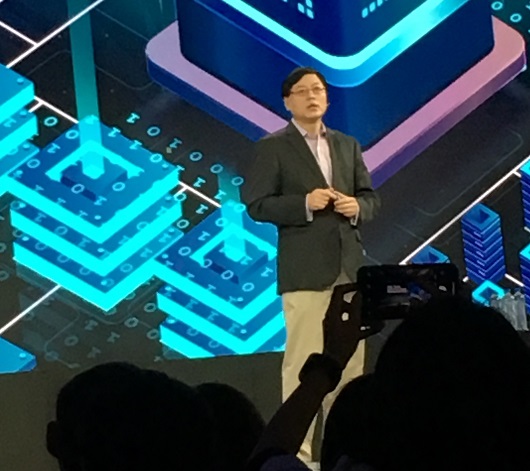Lenovo announced new products, partnerships, and solutions for business today at its annual Transform 2.0 event in New York.
Yuangqing (“YY”) Yang, Lenovo chairman and CEO, opened the event by touting the past year’s fiscal and product accomplishments, which include being the number one provider of supercomputers globally. “Now world the believes it when we say Lenovo has truly turned the corner to a new phase of growth and acceleration,” he said. “The last few years have lead us to the point where we can claim leadership of intelligent transformation.”
Partnership figures high in the drive to the future, he stressed. “To unlock our full potential to create the age of intelligent transformation, no company can drive it alone fully. We are eager to collaborate with all partners that can bring our vision to life.”
First up in the partnership arena was the Lenovo Data Center Group (DCG), which announced a multibillion-dollar global partnership with hybrid cloud data services company NetApp, of Sunnyvale, Calif. Leveraging the strengths of both companies, Lenovo and NetApp will develop and bring to market new high-performance and next-generation flash storage products and solutions that combine NetApp’s all-flash data management technologies with Lenovo’s ThinkSystem infrastructure. These new products will be manufactured by Lenovo.
Available now and shipping tomorrow are the first prods in the portfolio: the ThinkSystem DM Series All-Flash Array and DM Series Hybrid Flash Array. The ThinkSystem DE Series All-Flash Array and ThinkSystem DE Series Hybrid Flash Array will be available in October.
 “We are launching the largest data management and storage portfolio on our 25-year year data center history,” said Kirk Skaugen (pictured), who is an executive vice president of Lenovo and president of DCG. For Lenovo’s channel partners, the partnership will provide “competitive weapons that allow you to win against Dell, Dell EMC, and HP. And our channel ecosystem is highly complementary [with NetApp’s] with minimal overlap.”
“We are launching the largest data management and storage portfolio on our 25-year year data center history,” said Kirk Skaugen (pictured), who is an executive vice president of Lenovo and president of DCG. For Lenovo’s channel partners, the partnership will provide “competitive weapons that allow you to win against Dell, Dell EMC, and HP. And our channel ecosystem is highly complementary [with NetApp’s] with minimal overlap.”
Added Brad Anderson, senior vice president and general manager at NetApp for cloud infrastructure, “The success of channel partners and customers is job one.”
In an interview with ChannelPro, Stefan Bockhop, executive director of the DCG Channel for North America, stressed that Lenovo’s current partnership with Nutanix has been very succesful, so Lenovo is not taking “the foot off gas with the hyperconverged story.” The NetApp partnership, though, expands the storage conversation for both Lenovo and its partners. For managed service providers serving the SMB space in particular, infrastructure decisions are often done with compute and storage at the same time, he said. “Now our partners have the ability to solve both those problems simultaneously.”
Additionally, Lenovo and NetApp announced a new joint venture company in China to deliver storage products and data management solutions localized and tailored to meet China’s specialized requirements and distinct cloud ecosystem. The new venture is expected to be operational by spring 2019, pending local approvals.
On another partner front, Lenovo and Veeam extended their partnership with a global resell agreement. Now customers will be able to purchase Veam Intelligent Data Management solutions together with Lenovo software-defined infrastructure (SDI) and storage-area network (SAN) offerings directly from Lenovo and its resellers in a single transaction.
For its part, the Lenovo Intelligent Device Group (IDG) announced ThinkShield, a new approach to securing devices throughout their lifecycle. ThinkShield features a suite of technologies and controls, from BIOS and firmware for authentication and physical/virtual endpoint management, to physical camera shutters and fingerprint readers, to supply chain management.
The ThinkShield security innovations come “as a direct result of being much more customer focused and in a sense building what our customers are asking for proactively, versus thinking we have the recipe right from the onset,” said Matthew Zielinksi, president, North America, in an interview with ChannelPro.
ThinkShield is designed to protects users’ identities and credentials in several ways:
- FIDO-certified authenticators—plus match-on-chip fingerprint technology—to give companies safer, easier ways to protect their employees’ identities.
- Integration with Intel Authenticate—up to 7 authentication factors—fors greater security and flexibility.
- BIOS-based Smart USB protection allows IT professionals to configure USB ports to respond only to keyboards and pointing devices, keeping employees’ PCs safer.
In addition, Lenovo’s strategic partnership with Intel has enabled the company to align with the Intel Transparent Supply Chain, which allows customers to locate the source of each component of their new system.
Lenovo also oversees the security of suppliers who build intelligent components, making sure they conform to rigorous Trusted Supplier Program guidelines and best practices. For an extra layer of transparency, Lenovo Quality Engineers can audit suppliers at any time.
Lenovo also previewed AirStack, a software-as-a-service tech stack management solution designed to help organizations identify, manage, and optimize their software investment.
Finally, Lenovo showcased the latest addition to the ThinkPad X1 laptop portfolio, the ThinkPad X1 Extreme. The thin and light Windows 10 laptop is designed for advanced users and “prosumers” with high-performance computing needs, and is the first to include NVIDIA discrete graphics. According to Lenovo, it is ideal for data intensive workloads; video and photo editing; graphics rendering; and virtual and mixed reality applications.
In the smart office area, Christian Teismann, senior vice president and general manager for Lenovo’s Worldwide Enterprise Business group, also announced the next generation of Hub 500, the Hub 700, as well as a software platform that runs multiple videoconferencing software solutions on the same platform, which will be coming in December.
Looking ahead, Lenovo executives said partners should expect future announcements in 5G networking, IoT edge devices and servers, commercial augmented reality, and hardware as a service with flexible metering, among other areas.














